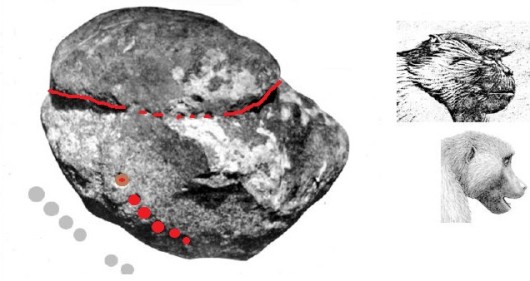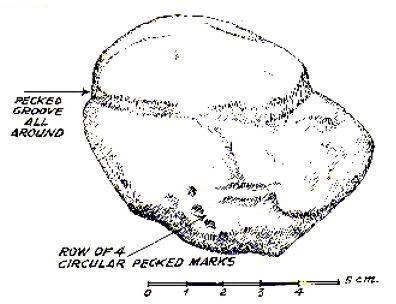
The question when man made his oldest art is important because it points to important mental capacities. In my first book on The History of Man (published in Dutch as ‘geschiedenis van de mens’) I argued that man had developed aesthetic feeling (the appreciation of beauty) through evolution, in the struggle for survival, a Darwinian view.
Art was everything man had made and evoked his aesthetic feeling. A very large definition but one that is necessary because it should cover the timeframe of more than 2 million years and all human cultures.
Three phases could be recognised in this evolution. The first phase in which man thought objects he found the nature were beautiful, e.g. the pebble of Makapansgat. It was not adapted by man, so in our definition it is not art. A second phase in which man retouched objects he found in nature, where he actively engaged. This is art because man changed an object to make it conform with what he found beautiful. All figurines are the Venuses of Berekhat Ram, 233.000/800.000 BP, and Tan Tan, 400.000 BP.
There is however a much older object that was adapted by man. It dates from 1.74 million years ago. That is the period, 1.8 M BP, that man gained control over fire, that acheulean tools were developed and Homo erectus/ergaster appeared. Mary Leakey published an article in 1971 with the results of the excavations in Olduvai between 1960 and 1963. It was in the surroundings that the oldest stone tools of hominids, 2.6 million years old, were found.
Her team had found a cobble of phonolite, a very hard-rock, that was adapted by man. It had a certain, natural resemblance with the head of a monkey. It was named baboonhead. It had a groove that ran around the skull. On the left cheek six cupules had been carved (see illustrations). Cupules would be made by man until recently, so during 1.8 million years. They were found in Africa, in India and were exported by man to Australia and Tasmania and -so to speak- recently in the Americas. A very long-lasting cultural continuity!
These and other finds reinforce the idea that man developed his mental capacities during a very long period and not in a short burst when Homo sapiens appeared.
Dr. Marc Vermeersch
Marc.Vermeersch@gmail.com
Additional information
Mary Leakey writes:
“In concluding this review of the lithic material from Oldowan and
Developed Oldowan Sites the grooved and pecked phonolite cobble found in Upper
Bed I at FLK North must be mentioned. This stone has unquestionably been
artificially shaped. But it seems unlikely that it could have served as a
tool or for any practical purpose. It is conceivable that a parallel exists
in the quartzite cobble found at Makapansgat in which natural weathering has
simulated the carving of two sets of hominid-or mre strictly primate- features
on parts of the surface. The resemblance to primate faces is immediately
obvious in this specimen, although it is entirely natural, whereas in the case
of the Olduvai stone a great deal of imagination is required in order to see
any pattern or significance in the form. With oblique lighting, however,
there is a suggestion of an elongate, baboon-like muzzle with faint
indications of a mouth and nostrils. By what is probably no more than a
coincidence, the pecked groove on the Olduvai stone is reproduced on the
Makapansgat specimen by a similar but natural groove and in both specimens the
positions of the grooves correspond to what would be the base of the hair line
if an anthropomorphic interpretation is considered. This is open to question,
but nevertheless the occurrence of such stones at hominid sites in such remote
periods is of considerable interest.”
M.D. Leakey, Olduvai Gorge3 Excavations in Beds I and II, 1960-1693, (Cambridge: Cambridge University Press, 1971), Vol. 3, p. 269
If you are interested in art you might like these blogs:
Art in Olduvai 1,74 Million Years BP, Baboonhead Rather unknown, undeserved, the oldest known art in the world
The Origin of Aesthetic Feeling and Art Fundamental: How our aesthetic feeling originated in reproduction of man, a darwinian explanation.
The oldest statuettes adapted by man are between 233,000 and 800,000 years old
“Lion Man”, the oldest statuette with a combination man-animal ‘Der Löwenmensch” was found in Germany.
The oldest Love Statuette in the World They keep on loving for ever in the British Luseeum.
A virtual visit to the Lascaux Cave is mind blowing!
Nerja Caves: the oldest Cave Art in Europe, 42,000 years old Rock paintings , probably made by neanderthals
